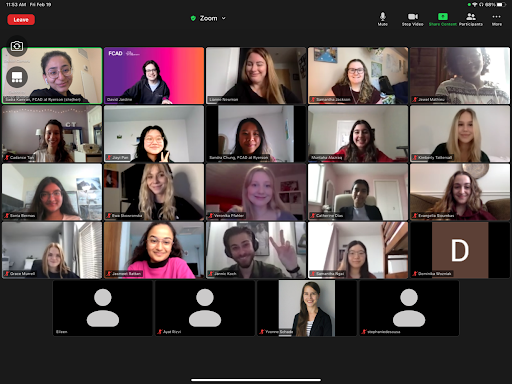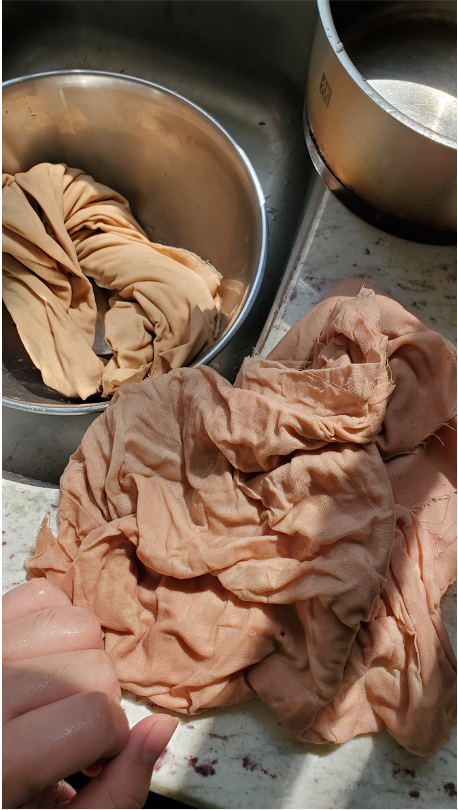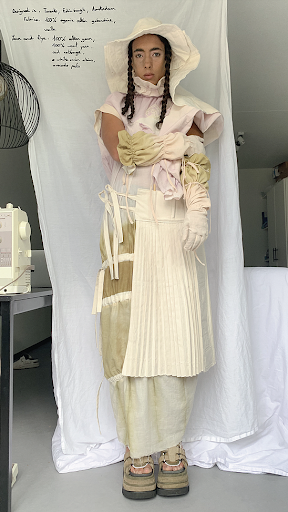How the pandemic has altered student exchange trips

Roy Luo enters the glorified hallway that is his Toronto basement for what feels like the millionth time. The claustrophobic space in his family home is to replace the spacious Kerr Hall classrooms filled with the industry-standard equipment that he’s become accustomed to. As a result, fabric of all shades pile on his piano bench, elliptical machine and other basement miscellany. Needing an area to draft, he takes to the living room floor upstairs. This design student, finishing his third year at Ryerson University’s fashion program, is on a deadline. He needs to get the tanned bodice piece he’s currently dying with organic red cabbage to the post office for shipping to group member Katie Morgan in Edinburgh, Scotland.
This transatlantic shipment is necessary because, midway through his exchange trip to the Amsterdam Fashion Institute (AMFI) last winter, a string of emails hit Luo’s inbox. COVID-19 was about to bring the world to its knees. He had to come home.

Roy Luo in the process of experimenting with a homegrown solution for dying garments. Pictured is fabric dyed with onion skins. (Courtesy Roy Luo)
With in-person classes now impossible, Luo, Ryerson and AMFI could have left the exchange. Other schools certainly did. One of Luo’s group members from South Korea, Seojin Kim, saw her institution decertify the program, when it determined a move online wouldn’t give students the requisite experience. She had no choice but to drop out.
Ryerson and AMFI, however, navigated the logistical minefield and moved the exchange online, marking the birth of a new era in international study.
“We have a much closer relationship with our international partners because of this shared experience,” says Sadia Kamran, Ryerson Faculty of Communication and Design’s manager of international development. “We see it as an opportunity to rethink what’s possible.”
In Luo’s case, this rethinking meant finding a way to continue with the seminal group project that he started in Amsterdam. Consisting of five physical outfits, four looks comprising five “blank canvas” garments meant for customization by the end buyer and five outfits made digitally on a fashion design software called CLO, the project would culminate in a complete collection featured on AMFI’s website. To complete the five physical looks, a sort of international assembly line formed between Luo and his four fellow group members — Yongju Jun, Kiki van der Weerd, Gabriela Syzdek and Morgan. Boxes containing partially constructed garments sent by Luo’s partners in Scotland or the Netherlands would arrive on his doorstep throughout what remained of the semester. Each one held a different garment. Luo would add a pink bodice here or a flowing off-white pant there and then ship it off to the next person, sometimes including national snacks or a postcard with the shipment.
Luo said the group incorporated the excitement that the unknown brings into their collection. He likened what happened to an exquisite corpse, the process of creation invented by the Surrealists whereby each artist contributes one part of a piece, and then the entire thing is revealed. “As we were working on our components, we wouldn’t share our process with the other designers,” Luo said. “It wasn’t until we shipped the garments that we could see what other people were working on.”
Luo and his partners’ work resulted in a complete collection of 15 custom looks, but it wasn’t all smooth sailing. “There was a point in the semester where I was just tired of it all,” he said. “I wanted to quit exchange because I was like, ‘What’s the point of doing this? I’m not getting the same physical experience.’” The different time zones also wreaked havoc on his semester. “Sometimes I didn’t even sleep,” he said. “I had to wake up at 5 a.m., and that would be the end of their day, but the start of mine.”
But when it got challenging for Luo, he discovered he could rely on his newfound friends in Utrecht, Amsterdam and Edinburgh. As the end of the semester drew near, meetings morphed into intercontinental game nights. “It was nice to be able to have those moments where we were able to bond and connect despite being so far away,” he said.

Roy Luo fabricated the pink top for this outfit at home in Toronto using biodegradable fabric. (Courtesy Amsterdam Fashion Institute)
Sandra Chung, who works with Kamran as FCAD’s international co-ordinator, acknowledges there are drawbacks to virtual exchange. “Because students in the past have only been able to do in-person exchanges, it’s a really small number of students that have been able to take part in a very enriching intercultural experience,” Chung said. “What virtual exchange can provide now is more students being able to take part…and get that exposure that not only helps them for their personal growth, but also their professional growth.”
That’s because this unique take on student movement is much cheaper than a full-on exchange trip, as it eliminates airfare and housing costs. Virtual exchanges open to Ryerson students can be found here.
Ryerson is also hosting virtual exchange students. Fifty students from around the world have taken courses at Ryerson since the pandemic began.
While, at first glance, a virtual exchange looks like something far removed from a truly international experience, some professionals believe that it provides cultural enrichment. “In some ways, with a face-to-face exchange, students don’t come back with that much of an intercultural experience because they don’t interact that much with the locals,” said Allison Broadbent, the University of Guelph’s study abroad manager. “The guided aspect that’s possible with a virtual exchange…helps students delve deeper into cultural differences and perspectives than maybe they would even get on a physical exchange.” Broadbent helped organize a virtual exchange for Guelph students with Farm Radio International in Africa.
Across Canada, students have swapped studying abroad for studying in bed. Even post-pandemic, however, expect virtual exchanges to remain an option. “Virtual exchange is a model to continue to explore and expand beyond COVID,” Kamran says. “The traditional exchange model will always exist, but virtual exchange as an alternative will continue to develop and enhance.”
